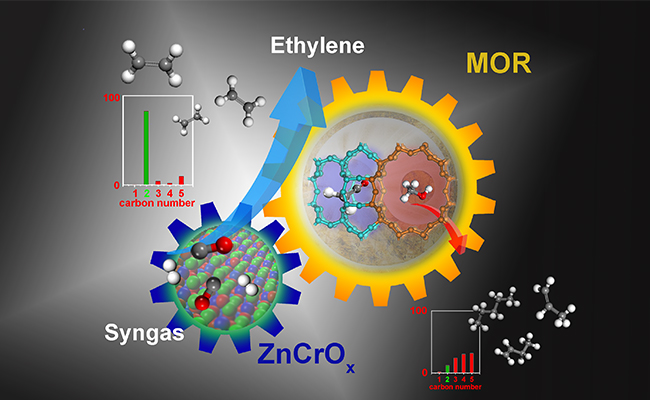The team led by Prof. PAN Xiulian and BAO Xinhe in Dalian Institute of Chemical Physics (DICP), Chinese Academy of Sciences (CAS) designed a new bifunctional catalyst, it could achieve the syngas conversion to ethylene with a high selectivity. The above results were just published online by Angewandte Chemie-International Edition as a "Hot Paper".
Accurately control the activation of CO as well as C-C coupling, has always been the most challenging problem in syngas chemistry, which is also the key to efficiently utilize coal and natural gas.
This team focus on catalytic conversion of syngas to high valuable chemicals. To overcome the selectivity limit of syngas conversion base on traditional Fischer Tropsch process, recently they reported a novel catalyst concept of oxide-zeolite (OX-ZEO): by separating CO activation and C-C coupling onto oxide and zeolites respectively.
According to their previous work, this catalyst had enabled direct conversion of syngas to mixed light olefins (Science, ACS Catalysis) and to aromatics (Chemical Communication).

Syngas conversion can be effectively steered toward ethylene via ketene intermediates by the 8MR side pockets of MOR employing the ZnCrOx-MOR composite (Image by JIAO Feng)
In this work, researchers further modified the OX-ZEO catalyst with ZnCrOx-mordenite (MOR). And the syngas conversion can be effectively steered toward to ethylene with this catalyst.
The selectivity of ethylene alone among hydrocarbons reached as high as 73% at 26% CO conversion, which is higher than those reported in direct conversion and multi-step via Methanol To Olefins (MTO) processes.
This opens a new avenue for development of syngas-to-ethylene technology. Furthermore, it demonstrates that the versatility of the bifunctional OX-ZEO catalyst concept, which may be developed into a new technological platform for syngas chemistry. (Text by JIAO Feng)